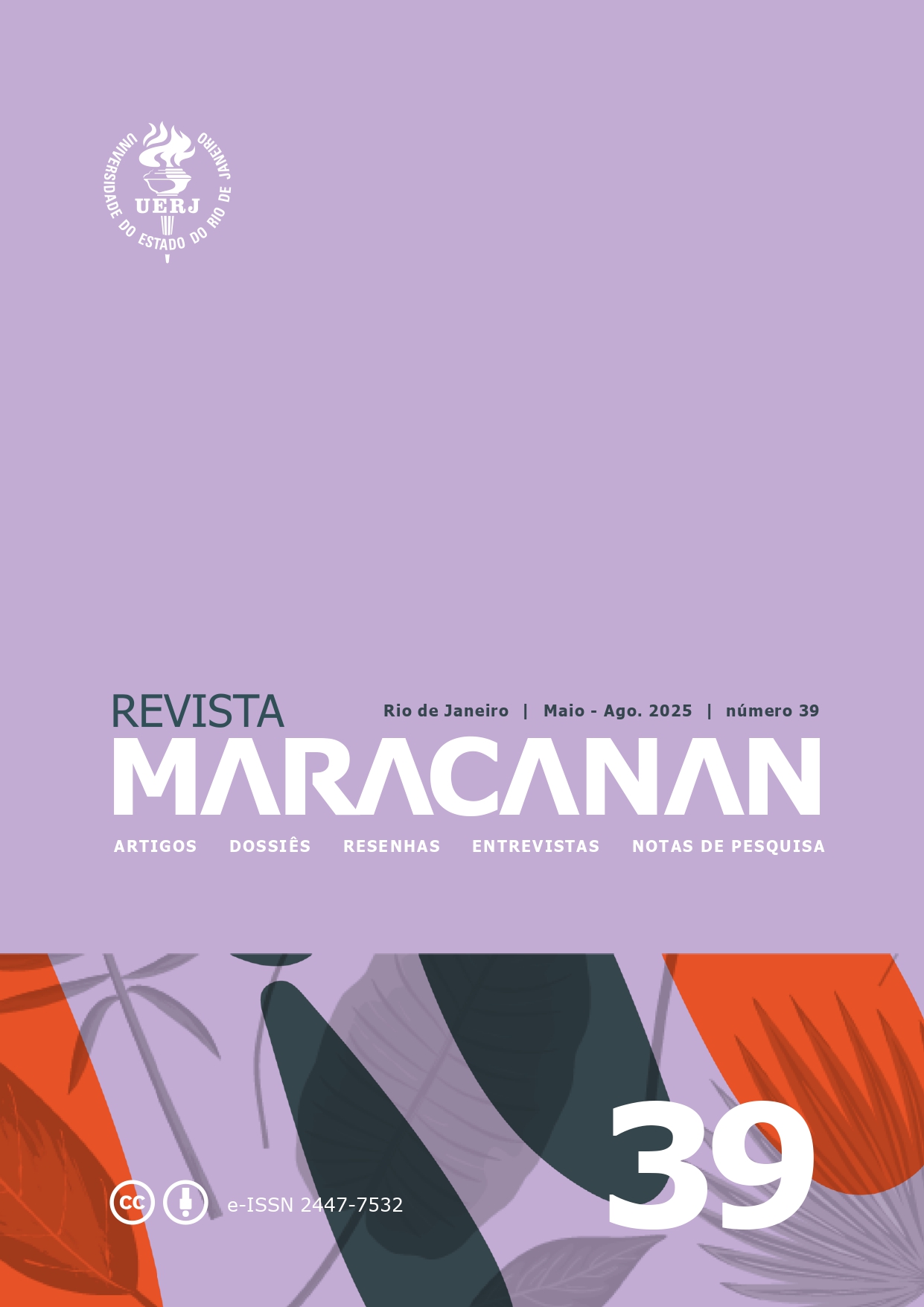La Commune da cooperativa Cinema do Povo
DOI:
https://doi.org/10.12957/revmar.2025.83436Palabras clave:
Cinema do Povo, Cinema Militante, ComunaResumen
O ponto de virada na consciência dos militantes sobre a importância de dominar o cinema teve como episódio pioneiro a criação da cooperativa francesa Cinema do Povo, em outubro de 1913. Este artigo se concentra na análise do último filme produzido pela cooperativa, em março de 1914, intitulado La Commune. O Cinema do Povo produziu, em menos de um ano, um total de seis filmes, dos quais três foram encontrados e restaurados pela Cinémathèque Française na década de noventa. O objetivo deste trabalho é investigar como o Cinema do Povo se debruçou sobre o repertório de representações artísticas disponíveis para o movimento operário durante os anos pré-Primeira Guerra Mundial. Este empenho da cooperativa visou, como sugerem as fontes, estabelecer um modo cinematográfico próprio de representação na produção do primeiro filme a tratar dos acontecimentos e do massacre da Comuna de Paris de 1871.
Citas
ABEL, Richard. The Ciné Goes to Town: French Cinema, 1896-1914. Updated and Expanded Edition. Berkeley: University of California Press, 1998.
AGULHON, M. Un usage de la femme au XIXe siècle: l’allégorie de la République. Mythes et représentation de la femmeau. Romantisme, Paris, n. 13-14, p. 143-152, 1976. DOI : https://doi.org/10.3406/roman.1976.5059.
ALMBERG, Nina. Les Cameras du Peuple. Cinéma et mouvement ouvrier à la Belle Epoque. 2010-2011. Mémoire (Master de Recherche en Histoire) – Institut d’Études Politiques de Paris, Ecole Doctorale, Sciences Po, 2010-2011.
BOUCHARD, Anne-Marie. “Mission sainte”. Rhétorique de l’invention de l’art social et pratiques artistiques dans la presse anarchiste de la fin du XIXe siècle. Études littéraires, v. 40, n. 3, p. 101-114, 2009. DOI: https://doi.org/10.7202/039247ar.
BURCH, Noël. La lucarne de l’infini – Naissance du langage cinématographique. Paris: L’Harmattan, 2007.
CAPELATO, Maria Helena et al. História e Cinema. São Paulo: Alameda, 2007.
CHENUT, H. Anti-feminist caricature in France: politics, satire and public opinion, 1890–1914. Modern & Contemporary France, London, v. 20, n. 4, 2012. DOI: https://doi.org/10.1080/09639489.2012.720433.
COSTA, F. C. Primeiro Cinema. In: MASCARELLO, Fernando (Org.). História do Cinema Mundial. Campinas, SP: Papirus, 2006.
DARDEL, Aline. Catalogue des dessins et publications illustrées du Journal Anarchiste ‘’Les Temps Nouveaux’’ 1895-1914. 1980. Thèse (Doctorat de troisième cycle en Histoire de l’Art) – Université de Paris IV, 1980.
FIAUX, Louis. Histoire de la Guerre civile de 1871. Paris: Charpentier, 1879.
FOURNIER, Eric. La Commune de 1871 : un sphinx face à ses images. Sociétés & Représentations, v. 2, n. 46, p. 245-257, 2018. DOI: https://doi.org/10.3917/sr.046.0245.
GUERRA, Armand. Algo sobre la cooperativa UCCE. Popular Film. CNT, 28 mar. 1935. Disponível em: http://archivo.cnt.es/Documentos/cineyanarquismo/armand_guerra.htm. Acesso em: 28 jan. 2021.
LISSAGARAY, Prosper Olivier (1838-1901). Auteur du texte. Histoire de la commune de 1871. Paris: Librarie Dentu, 1896.
LUCE Maximilien. Le Maitron. Dictionnaire Biographique, 11 fév. 2009. Disponível em: https://maitron.fr/spip.php?article24489. Acesso em: 10 abr. 2024.
MENOTTI, Gabriel. Arquitetura da Espectação: A construção histórica da Situação Cinema nos espaços de exibição cinematográfica. Ciberlegenda, Niterói (RJ), ano 9, n. 18, jul. 2007.
MESALIRA, M. F. M. Músicos e orquestras do primeiro cinema em greve: de Chicago ao Rio de Janeiro (1903-1914). Esboços: Histórias Em Contextos Globais, v. 28, n. 47, p. 17–37. 2021. DOI: https://doi.org/10.5007/2175-7976.2021.e74792.
MEUSY, J-J. Paris-Palaces ou le temps des cinémas (1894-1918). Paris: CNRS, 2002.
MUNDIM, Luiz F. C. O público organizado para a luta: o Cinema do Povo na França e a resistência do movimento operário ao cinema comercial (1895-1914). 2016. Tese (Doutorado em História) – Universidade Federal do Rio Grande do Sul; Université Paris 1 Sorbonne, Porto Alegre; Paris, 2016.
MUNDIM, L. F. C. As misérias da agulha do Cinema do Povo: um filme feminista no primeiro cinema. Significação: Revista de Cultura Audiovisual, v. 46, n. 52, 2019. DOI: https://doi.org/10.11606/issn.2316-7114.sig.2019.147866.
PERRON, Tangui. Le cinéma militant – Les origines du cinéma militant (ou le cinéma militant et la mort). In: KERMABON, Jacques; ERVARD, Jacky (Org.). Une Encyclopédie du Court Métrage Français. [S. l.] : Crisnée: Édition Yellow Now et Festival Côté Court, 2003. Disponível em: http://www.peripherie.asso.fr/mouvement-ouvrier-et-cinema/le-cinema-militant. Acesso em: 15 abr. 2021.
PERRON, Tangui. Vie, mort et renouveau du cinéma politique. L’Homme et la Société, n. 127-128, p. 7-14, 1998.
PERRON, Tangui. Histoire, cinéma, CGT et un peu de banlieue. In: GIRAULT, Jacques. Ouvriers en banlieue. Paris: L’Atelier, 1998.
PERRON, Tangui. Le contrepoison est entre vos mains, camarades’ – C.G.T. et cinéma au début du siècle. Le Mouvement Sociale, L’atelier, Paris, n. 172, p. 21-36, juil.-sept. 1995.
PESSIN, Alain. La rêverie anarchiste. 1848-1914. Lyon: Atelier de Création Libertaire, 1999.
PIGENET, Michel; ROBERT, Jean Louis. Travailleurs, syndiqués et syndicats dans les dessins de La Voix du Peuple (1900-1914). Sociétés & Représentations, v. 2, n. 10, p. 309-322, 2000. DOI: https://doi.org/10.3917/sr.010.0309.
PROST, A. Si nous vivions em 1913. Paris: Grasset, 2014.
RIOT-SARCEY, M. Les femmes et la gauche en France : entre discours émancipateurs et pratiques de domination. In: BECKER, J-J. et al. Histoire des gauches en France. Paris: La Découverte, 2005.
TILLIER, Bertrand. La Commune de Paris, révolution sans images : politique et représentations dans la France républicaine (1871-1914). Ceyzérieu: Champ Vallon, 2004.
XAVIER, Ismail. Sétima Arte: um Culto Moderno. o Idealismo Estético e o Cinema. São Paulo: Perspectiva, 1978.
Descargas
Publicado
Cómo citar
Número
Sección
Licencia
Derechos de autor 2025 Luiz Felipe Cezar Mundim

Esta obra está bajo una licencia internacional Creative Commons Atribución 4.0.
Os autores mantêm os direitos autorais e concedem à Revista Maracanan o direito de publicação, sob uma Licença Creative Commons Atribuição 4.0 Internacional, a qual permite que outros distribuam, remixem, adaptem e criem a partir do seu trabalho, mesmo para fins comerciais, desde que lhe atribuam o devido crédito pela criação original.
Os dados e conceitos abordados são da exclusiva responsabilidade do autor.
A Revista Maracanan está licenciada com uma Licença Creative Commons Atribuição 4.0 Internacional.





